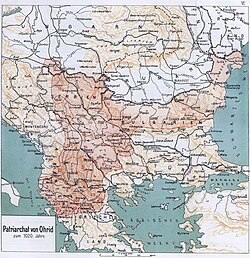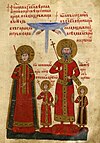Archbishopric of Ohrid
The designation finally became accepted by Constantinople and the Byzantine imperial chancery after 1261, and a fixed part of the archbishops' titulature; in the fullest form, the see was hence known as the Archbishopric of Justiniana Prima, Ohrid and all Bulgaria (ἀρχιεπίσκοπὴ Πρώτης Ἰουστινιανῆς Ἀχριδῶν καὶ πάσης Βουλγαρίας).[4] Shortly after 934, the Byzantine emperor Romanos I Lekapenos recognized the head of the Bulgarian Orthodox Church, Archbishop Damian, to the rank of patriarch, following the terms of the peace treaty that ended the Byzantine–Bulgarian war of 913–927.[6] During his rule, the residence of the Bulgarian patriarchs remained closely connected to the developments in the war between Samuel and the Byzantine emperor Basil II.[7] Although the first appointed archbishop (John of Debar) was a Bulgarian from Kutmichevitsa, his successors, as well as the whole higher clergy, were invariably Byzantine, the most famous of them being Saint Theophylact (1078–1107).The Latin conquests, the restoring of the Bulgarian Empire and the formation of an independent Serbian state reduced the jurisdiction of the Ohrid Archbishopric immensely, but it did not disappear.During the time of Archbishop Demetrios Chomatenos, the autocephaly of the Archbishopric was confirmed with the act of anointing the despot of Epirus, Theodore Komnenos Doukas, as Emperor and in correspondence with the Patriarch.By the 1520s, the Archbishopric of Ohrid had managed to put practically the entire Serbian Church under its jurisdiction, however, by the intervention of Sokollu Mehmed Pasha in 1557, the latter was renewed and reorganized.The autocephaly of the Ohrid Archbishopric remained respected during the periods of Byzantine, Bulgarian, Serbian and Ottoman rule; the church continued to exist until its abolition in 1767, when it was abolished by the Sultan's decree, at the urging of the Greek Eastern Orthodox leaders of Istanbul, and was placed under the jurisdiction of the Patriarch of Constantinople.Despite the creation of new bishoprics from existing ones, by the middle of the 12th century the number of suffragans—apart from Ohrid itself—had decreased to 23 (modern names in parentheses): Kastoria, Skopia (Skopje), Belebousdion (Velbazhd), Sardike or Triaditza (Sofia), Malesobe or Morobisdion (unlocated), Edessa or Moglena, Herakleia (Bitola) or Pelagonia, Prisdiana, Tiberioupolis or Stroummitza (Strumica), Nisos, Kephalonia or Glabinitze, Morabos or Branichevo, Sigida or Belegrada (Belgrade), Bidine (Vidin), Sirmion (Sremska Mitrovica), Lipenion, Rhasos (Ras), Selasphoros or Diabolis (Devol), Slanitza or Pella, Illyrikon or Kanina, Grebenon (Grevena), Drastar (Silistra), Deure (Debar), and the Vreanoti (Vranje), called also "bishopric of the Vlachs".



Macedonian Orthodox Church – Ohrid ArchbishopricOrthodox Ohrid ArchbishopricArchbishopric of Ohrid (disambiguation)BulgarianMacedonianautocephalousEastern Orthodox ChurchByzantine conquest of BulgariaBulgarian PatriarchatetutelagePatriarchate of ConstantinopleTheophylact HephaistosJohn IVJohn II KomnenosArchbishopric of Justiniana PrimaJustinian IDemetrios ChomatenosEmpire of NicaeaByzantine emperorRomanos I LekapenosBulgarian Orthodox ChurchpatriarchByzantine–Bulgarian war of 913–927John I TzimiskesBulgariaSamuel of BulgariaBasil IIMoglena (Almopia)Vodena (Edessa)Prespafinal subjugationprimatechurch synodsigilliaJohn of DebarKutmichevitsaTheophylactJohn (IV)KamaterosLatin EmpireDespotate of EpirusSecond Bulgarian EmpireSerbiafall of ConstantinopleKaloyanBulgarian EmpireTheodore Komnenos DoukasSkopjeSerbian Archbishopric of PećStefan DušanEasterJoanikije IINicholas I of OhridSimeon of BulgariaMount AthosBattle of MaritsaBattle of KosovoOttoman TurksPrince MarkoSerbian PatriarchSokollu Mehmed PashaDanubeWallachiaMoldovaSouthern ItalyDalmatiaVeroiaDurazzoEcumenical Patriarchate of ConstantinoplephanariotesautochthonistsSerbian Patriarchate of PećGreek languageOld Church SlavonichagiographiesClement of Ohridautocephalous churchmilletsuffragan seesKastoriaSkopia (Skopje)VelbazhdEdessa or MoglenaHerakleia (Bitola) or PelagoniaTiberioupolis or Stroummitza (Strumica)KephaloniaSigida or Belegrada (Belgrade)Rhasos (Ras)Selasphoros or Diabolis (Devol)Illyrikon or KaninaArchbishop of OhridMacedonian Orthodox ChurchSerbian Orthodox ChurchRoman Catholic Archdiocese of OhridĆirković, SimaFine, John V. A. Jr.Gelzer, HeinrichVraniskovski, JovanOikonomides, NicolasNicol, Donald M.Obolensky, DimitriOstrogorsky, GeorgeRunciman, StevenCatholic EncyclopediaTopicsFirst Bulgarian EmpireBulgarsSouth SlavsOld Great BulgariaTsardom of VidinDespotate of Dobruja (Principality of Karvuna)Council of PreslavPliskaPreslavTarnovoNicopolisAsparukhTervelOmurtagBoris ISimeon IPeter ISamuelIvan Asen IIvan Asen IIKonstantin Tih